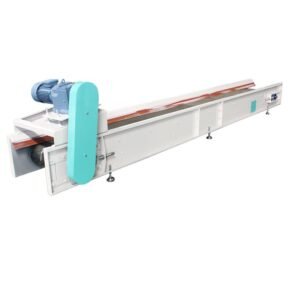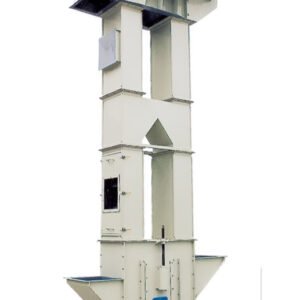Description
Technical Specifications & Design Configurations
Capacity & Speed Ranges
-
Throughput Capacity: 5 m³/h to 500 m³/h (standard models)
-
Lift Heights: 10 meters to 150 meters (custom designs available)
-
Operating Speed: 0.5 m/s to 2.5 m/s (application optimized)
-
Bucket Sizes: 1 liter to 50 liters capacity (continuous or centrifugal)
Drive & Power Systems
-
Motor Power: 5.5 kW to 250 kW (based on height and capacity)
-
Drive Arrangements: Top-mounted reducers with backstop devices
-
Speed Control: Fixed or variable frequency drive options
-
Safety Features: Torque-limiting couplings, overspeed switches
Construction & Materials
-
Casing Types: Chain-driven (high capacity) or belt-driven (gentle handling)
-
Bucket Materials: Polyethylene, nylon, steel, or stainless steel
-
Chain/Belt Options: Roller chain, forged chain, or steel-reinforced belt
-
Protection Systems: Explosion venting, fire suppression, monitoring ports
Performance Specifications by Configuration
| Elevator Type | Typical Capacity | Max Height | Speed Range | Optimal Applications |
|---|---|---|---|---|
| Centrifugal Discharge | 10-200 m³/h | 50m | 1.2-2.0 m/s | Free-flowing granular materials |
| Continuous Discharge | 5-150 m³/h | 100m | 0.5-1.2 m/s | Fragile or abrasive materials |
| Super-Capacity | 50-500 m³/h | 150m | 0.8-1.6 m/s | High-volume bulk handling |
| Positive Discharge | 10-100 m³/h | 30m | 0.3-0.8 m/s | Sticky or cohesive materials |
Key Performance Metrics:
-
Mechanical Efficiency: 85-95% energy transfer efficiency
-
Fill Factor: 75-85% achievable with proper boot design
-
Power Consumption: 0.8-2.5 kWh per vertical ton lifted
-
Noise Levels: 75-85 dB without acoustic treatment
Industry-Specific Engineering Solutions
Grain & Agriculture Processing
Bucket elevators form the vertical backbone of grain handling facilities, with capacities up to 300 m³/h and heights exceeding 60 meters. Modern grain elevators feature USDA-accepted materials, quick-clean designs, and explosion protection systems. One major grain terminal documented 99.5% availability over 12 months while handling 2.5 million tons of wheat.
Cement & Mineral Processing
Heavy-duty elevators handle highly abrasive materials with minimal degradation. Features include wear-resistant buckets, hardened chains, and impact-resistant boot sections. A cement plant achieved 8,000 hours of continuous operation between major maintenance intervals through proper material selection and preventive maintenance.
Chemical & Food Processing
Sanitary designs with polished surfaces, quick-disconnect buckets, and washdown-rated components ensure compliance with strict hygiene standards. A food processor reduced cleaning time by 70% while maintaining 99.9% product integrity through gentle handling designs.
Mining & Bulk Terminals
High-capacity elevators move thousands of tons per hour with reliability exceeding 98%. Features include redundant drive systems, online monitoring, and emergency access points. One mining operation moves 800 t/h of copper concentrate vertically 45 meters with 92% mechanical efficiency.
Advanced Features & Monitoring Systems
Intelligent Control Systems
-
Load Monitoring: Real-time power consumption analysis
-
Speed Optimization: Automatic adjustment based on feed rate
-
Predictive Maintenance: Vibration and thermal monitoring
-
Safety Integration: Interlocked access and emergency stops
Discharge & Loading Optimization
-
Feed Control: Automated boot level management
-
Discharge Geometry: Optimized head section design
-
Material Flow: Advanced chute designs minimizing impact
-
Dust Control: Integrated aspiration and filtration systems
Wear Protection & Longevity
-
Bucket Design: Reinforced lips and wear strips
-
Chain Protection: Lubrication-free bushings and coatings
-
Casing Liners: Replaceable wear surfaces in impact zones
-
Corrosion Protection: Specialized coatings for harsh environments
Operational Economics & Maintenance
Total Cost of Ownership Analysis
-
Capital Investment: $15,000-$150,000 based on height and capacity
-
Installation Costs: 20-35% of equipment cost for structural support
-
Energy Consumption: $1.50-$8.00 per operating hour
-
Maintenance Costs: 2-4% of initial investment annually
Maintenance Optimization
-
Daily: Visual inspection, lubrication check, unusual noise monitoring
-
Weekly: Belt/chain tension verification, alignment checks
-
Monthly: Bucket inspection, wear component measurement
-
Annually: Complete overhaul and performance validation
Component Life Expectancy
-
Buckets: 2-5 years depending on material abrasiveness
-
Chains/Belts: 3-8 years with proper tension maintenance
-
Sprockets/Pulleys: 5-10 years with regular inspection
-
Structural Casing: 15-25 years with proper maintenance
Safety & Environmental Considerations
Safety Systems
-
Explosion Protection: Vent panels, suppression systems, isolation valves
-
Mechanical Safeguards: Backstops, overspeed devices, torque limiters
-
Access Safety: Interlocked inspection doors, fall protection
-
Emergency Stops: Multiple strategically located stop stations
Environmental Compliance
-
Dust Emissions: <20 mg/m³ with proper filtration
-
Noise Control: <80 dB with acoustic treatments
-
Energy Efficiency: MEPS compliance for motor systems
-
Material Containment: Zero discharge designs
Future Development & Innovation Trends
Technology Evolution
-
Smart Monitoring: Wireless sensor networks for real-time health monitoring
-
Advanced Materials: Composite components reducing weight and wear
-
Energy Recovery: Regenerative drives capturing potential energy
-
Digital Integration: Cloud-based performance analytics and benchmarking
Design Innovations
-
Modular Construction: Faster installation and component replacement
-
Self-Cleaning Designs: Reduced maintenance requirements
-
Hybrid Drives: Multiple power sources for energy flexibility
-
Adaptive Control: AI-driven optimization of operation parameters
Market Directions
-
Sustainability Focus: Energy-efficient designs and recyclable materials
-
Global Standardization: Uniform safety and performance standards
-
Customization: Application-specific engineering solutions
-
Lifecycle Optimization: Designs prioritizing total cost of ownership
Bucket elevator technology continues to be the vertical workhorse of bulk material handling, providing reliable, efficient elevation across countless industrial applications. Their evolution from simple mechanical lifts to sophisticated, monitored systems reflects the industry’s ongoing pursuit of higher efficiency, greater reliability, and enhanced safety. As manufacturing and processing industries continue to prioritize vertical integration and space optimization, bucket elevators will remain essential infrastructure, continually incorporating new technologies to meet evolving operational demands and sustainability requirements.




Reviews
There are no reviews yet.